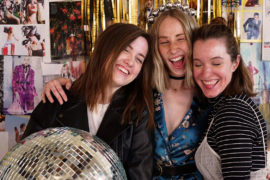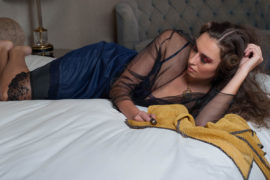Sam Miro is an Indianapolis-born filmmaker who recently worked with Young & Laramore on a digital campaign for Goodwill of Central Indiana. Miro made a series of videos profiling six local fashion designers as they transformed items found in local Goodwill stores into one-of-a-kind sartorial creations. The goal of the campaign was to promote Goodwill as a source of endless inspiration for artists and fashionistas alike.
Outside of working on ad campaigns, Miro has made two award-winning documentaries: Under the Bridge, a documentary about the criminalization of homelessness, and Little Warriors, a short documentary about youth climate change activists in Indianapolis. He stopped by PATTERN to talk about his experiences, and the uniqueness of the Goodwill campaign.
Julia Bluhm: How did you end up becoming a filmmaker?
Sam Miro: The first time I picked up a camera and actually worked on a project was my sophomore year in high school. It was about botany or zoology, and I just decided to mess with this digital camera and see what we could do with it. And I just shot something with my friend, and we dressed him up like a tree, and it ended up working really well. We got an A. So after that I tried to find a way to keep doing something with a camera, to see if I enjoyed it. I think this interest was also instilled in me at a young age because my dad would always bring electronics and cameras home, and I was fascinated by them and liked messing with them.
I got my undergrad from the IU school of informatics and computing at IUPUI. My degree included video, audio, 3D, gaming and web. So I’ve taken classes in all of those. I’m doing that for my master’s as well, but with a focus on video storytelling.

JB: What kinds of film projects and stories interest you?
SM: I think, for someone as young as I am who has mainly zero resources, like no money, what’s realistic? I have equipment, so what can I go out and do right now? I found documentaries have been the most realistic avenue for telling a story for me. My first two films have been documentaries, and have been on the topic of social activism. I’d say that’s kind of my niche. Raising awareness for things that the public should care about is really important. I’m also starting to work on more narrative stuff too though, I don’t limit myself.
JB: What’s it like being a filmmaker in Indianapolis?
SM: I’m in no rush to leave Indy. I think I want to stay here for another two to three years. It is what it is, and you make it what you can. I travel a lot for projects, and I think getting jobs here isn’t too difficult but there’s just not a surplus of them. But if you hustle hard and network, there is opportunity here. And a lot of stuff you do here is your own – your own projects and stories that you find.
JB: How did the Goodwill project start?
SM: Y&L wanted to do something a bit more fashion-focused for the fall digital campaign for Goodwill (who is their client) and they decided to team up with PATTERN to find a way to make thrifting cool and create something with it. Y&L’s creative director, Carolyn Hadlock, told me about how PATTERN was helping coordinate six fashion designers, who would repurpose clothing from Goodwill and then do a fashion editorial with the finished pieces for the print magazine. I basically documented all that taking place.

JB: What was your process like?
SM: I was briefed on what they were going to do, and a lot of the designers had already gone shopping so we did a lot of staged shopping. But basically I went to the Goodwill in their area (we went to six different Goodwill stores), I went back to their space and their studio, shot a sit down interview, and shot the construction and design of their clothes. It was a start to finish process. We wanted to tell a thirty second to two minute story for social media and web use.
As far as motifs and stuff, they told me they wanted some focus on people’s hands, doing things. So I made sure to get a lot of really tight macro-type shots throughout the entire piece. I knew I wanted to do the interviews straight-on, I didn’t want to do a rule of thirds.
JB: What were some challenges with the project?
SM: I was doing it all on my own– carrying my camera and tripod and equipment by myself. That’s definitely difficult. I had to be realistic about what I could do, based on what was available for me. I had the PATTERN interns following me around, but besides that I didn’t have that many hands and I didn’t have lighting. But we used natural light. I think overall it turned out really well. It was hard to communicate with six different people, but I ended up becoming friends with all of them and still am connected with them on social media and stuff.


JB: What did you like about the experience?
SM: It was a really unique project. Everything turned out really, really cool. PATTERN did a good job picking the fashion designers and who worked on the project. Everything was super unique and super avant-garde. When you have that kind of uniqueness with projects like this, that separates you from other fashion-related campaigns. Plus, it’s nice that Goodwill is reinventing themselves a bit, they’re trying to reach out to a younger crowd and show that Goodwill is an outlet for creative people. Art is transformative and universal.
You can follow Sam’s work at workofmiro.com or @workofsam on Instagram.




